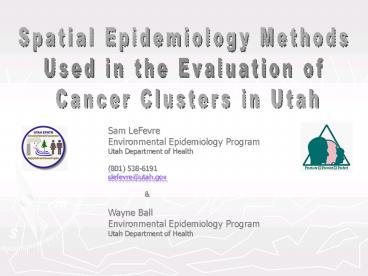Spatial Epidemiology Methods - PowerPoint PPT Presentation
1 / 34
Title:
Spatial Epidemiology Methods
Description:
Spatial Epidemiology Methods – PowerPoint PPT presentation
Number of Views:138
Avg rating:3.0/5.0
Title: Spatial Epidemiology Methods
1
Spatial Epidemiology Methods Used in the
Evaluation of Cancer Clusters in Utah
Sam LeFevre Environmental Epidemiology
Program Utah Department of Health (801)
538-6191 slefevre_at_utah.gov Wayne
Ball Environmental Epidemiology Program Utah
Department of Health
2
Collaborators
- Environmental Epidemiology Program
- Utah Department of Health
- www.health.utah.gov/enviroepi
- Utah Cancer Registry
- University of Utah
- www.uuhsc.utah.edu/ucr
- Environmental Public Health Tracking Program
- Centers for Disease Control and Prevention
- www.cdc.gov/nceh/tracking
- Small Area Health Statistic Unit
- Imperial College London
- www.sahsu.org
3
Background
- 1996 Environmental Epidemiology
- Program established in Utah
- 1998 SaTScan software
- 1999 SpaceStat
- 2002 Applied for Environmental Public Health
- Tracking Grant funds from CDC
4
Background
- 2003 RIF demonstrated at a EUROHEI conference
in Sweden - 2004 RIF re-engineered
- 2004 Utah acquires and prepares data
- 2005 First implementation and pilot study
5
(No Transcript)
6
The Study Area
- 11 Zip Codes
- 143 Census Block Groups
- 247,000 Persons
7
Methods Setup
8
Definition of Cancer Type
Utah Cancer Registry (SEER) Site Code
ICDO-3 ICD-10
13 Lung and Bronchus 36 Non-Hodgkins
428
C34 Lung and Bronchus 9050-9055 Mesothelioma
C34 Lung and Bronchus C45 Mesothelioma
430
1
2
1
20 Cervix 36 Non-Hodgkins
73
C53 Cervix
C53 Cervix
74
1
28 Kidney Renal Pelvis
98
C64 Kidney C65 Renal Pelvis
C64 C65 Kidney Renal Pelvis
108
10
Number of Cases in the Study Area (Exposed and
Unexposed Populations) from 1990 through 2000
9
Standard Population
Utah 2000
US Std 2000
World Std 1991
10
Median Income
SDI Deviation from Mean of Median Income 1 lt
1.0 STD Below Mean 2 1.0 0.5 STD Below
Mean 3 0.5 Mean 4 Mean 0.5 STD Above
Mean 5 0.5 1.0 STD Above Mean 6 gt 1.0 STD
Above Mean
11
Residential Tenure
Deviation from Mean Percentage
of SDI Population at Residence more than 5
years 1 lt 1.0 STD Below Mean 2 1.0 0.5 STD
Below Mean 3 0.5 Mean 4 Mean 0.5 STD Above
Mean 5 0.5 1.0 STD Above Mean 6 gt 1.0 STD
Above Mean
12
Findings
- RIF
- Lung and bronchus
- Kidney and renal pelvis (with covariate)
- SaTScan
- Lung and bronchus
- and a whole bunch of other types
13
Lung and Bronchus
Observed is the number of cases in the
potentially exposed population RR Relative
Risk LCL 95 Lower Confidence Limit UCL 95
Upper Confidence Limit SDI Socio-Economic
Deprivation Index (ranked Median Income) RT
Residential Tenure (ranked median)
14
- Disease Mapping
- Relative risk for each small area
- Adjusted and/or smoothed
- Multiple adjustments
- Risk Mapping
- Identifies potentially exposed population using
distance bands - Relative risk for the exposed population
15
Weber County
Hill AFB
Davis County
The Great Salt Lake
Weber County
Weber County
Hill AFB
Hill AFB
Davis County
Davis County
The Great Salt Lake
The Great Salt Lake
16
Kidney and Renal Pelvis
Observed is the number of cases in the
potentially exposed population RR Relative
Risk LCL 95 Lower Confidence Limit UCL 95
Upper Confidence Limit SDI Socio-Economic
Deprivation Index (ranked Median Income) RT
Residential Tenure (ranked median)
17
Kidney and Renal Pelvis
18
Kidney and Renal Pelvis
Weber County
Hill AFB
Study Area
Davis County
The Great Salt Lake
19
Layton Brain Cancer Study
20
Methods
21
Brain
Observed is the number of cases in the
potentially exposed population SIR Standardized
Incidence Ratio RR Relative Risk LCL 95
Lower Confidence Limit UCL 95 Upper Confidence
Limit SDI Socio-Economic Deprivation Index
(ranked Median Income)
22
Brain
CLUSTER by SaTScan
23
Brain
Weber County
Hill AFB
Study Area
Davis County
The Great Salt Lake
24
(No Transcript)
25
Lung Cancer Risk in Surrounding Neighborhoods
26
Lung Cancer Risk in Surrounding Neighborhoods
27
- News Release
- April 5, 2007
- ... in the two-mile radius study area ...
cancers of the respiratory system ... were
elevated. - ... exposure from the processing facility not
likely a significant factor ...
28
Childhood Leukemia High Traffic Roads
- 28,279 Census Blocks
- 465 children with leukemia (ALL AML)
- 11,212,093 child (0-14 years age)-years 1973-2001
- 2,514 km high traffic density roads
- 1,436 UDOT monitoring points
29
Risk Assessment
All Childhood Leukemia
30
Line Source Air Dispersion Model
Q Source strength (emission per distance) ? Wind
direction relative to line source ? Wind
speed ?Z Vertical dispersion factor a
xb H Effective source height
31
Monticello Uranium Tailings
32
Study Results
- Between 1973 2003, the overall cancer rate was
lower than expected based on state rates. - Lung cancer was elevated for one period (8 cases,
RR 2.39 95 CI 1.02-4.34) - All other cancers types that could be associated
with exposure to the tailings were not elevated.
33
Conclusions
- Differences in methods used and data setup
applied did not alter the findings or conclusions
of the study - RIF Relative Risk generally slightly more
conservative than SIR method - RIF allows the flexibility to follow leads
derived from analysis
34
Your Turn































